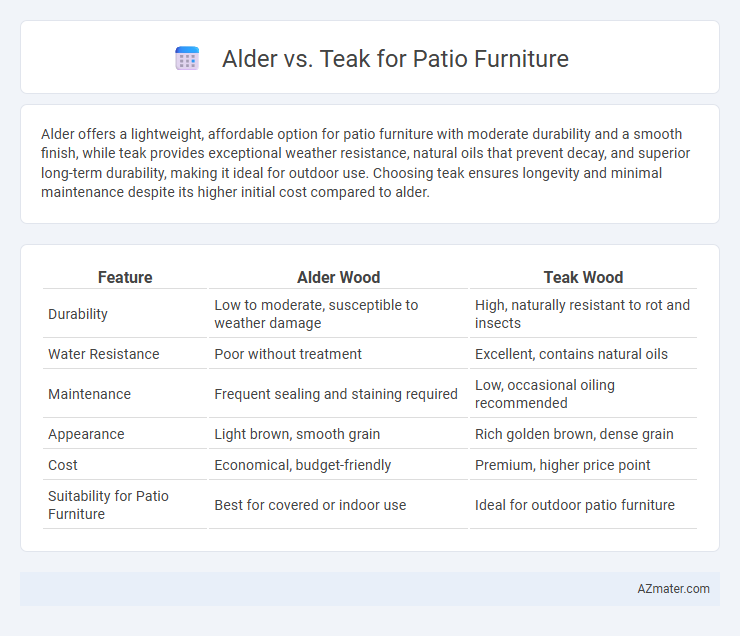Alder offers a lightweight, affordable option for patio furniture with moderate durability and a smooth finish, while teak provides exceptional weather resistance, natural oils that prevent decay, and superior long-term durability, making it ideal for outdoor use. Choosing teak ensures longevity and minimal maintenance despite its higher initial cost compared to alder.
Table of Comparison
| Feature | Alder Wood | Teak Wood |
|---|---|---|
| Durability | Low to moderate, susceptible to weather damage | High, naturally resistant to rot and insects |
| Water Resistance | Poor without treatment | Excellent, contains natural oils |
| Maintenance | Frequent sealing and staining required | Low, occasional oiling recommended |
| Appearance | Light brown, smooth grain | Rich golden brown, dense grain |
| Cost | Economical, budget-friendly | Premium, higher price point |
| Suitability for Patio Furniture | Best for covered or indoor use | Ideal for outdoor patio furniture |
Introduction to Alder and Teak Patio Furniture
Alder and teak are popular choices for patio furniture, each offering unique qualities suited to outdoor use. Alder wood is known for its smooth texture and warm reddish-brown hue, providing an affordable and lightweight option for stylish patio settings. Teak boasts exceptional durability and natural oil content, making it highly resistant to moisture, insects, and weather elements for long-lasting outdoor furniture.
Botanical Background: Alder vs Teak
Alder (Alnus spp.) is a deciduous hardwood native to the Northern Hemisphere, known for its relatively fast growth and moderate durability, making it a cost-effective choice for patio furniture with a warm, light reddish-brown hue. Teak (Tectona grandis), a tropical hardwood from Southeast Asia, is highly valued for its exceptional oil content, dense grain, and remarkable resistance to moisture, insects, and decay, making it ideal for outdoor furniture with a rich golden-brown color that ages to a silver-grey patina. Both woods belong to distinct botanical families--Betulaceae for Alder and Lamiaceae for Teak--and their differing growth environments and wood chemistry significantly influence their performance and aesthetic appeal in patio applications.
Durability and Weather Resistance
Teak is renowned for its exceptional durability and natural oils that provide superior weather resistance, making it ideal for patio furniture in harsh outdoor conditions. Alder, while softer and more affordable, lacks the dense grain and natural oils of teak, resulting in lower resistance to moisture, rot, and insect damage. For long-lasting outdoor use with minimal maintenance, teak outperforms alder in weather resistance and overall durability.
Appearance and Aesthetic Appeal
Alder wood offers a warm, reddish-brown hue with a smooth, fine grain that gives patio furniture a rustic and cozy aesthetic. Teak features a rich golden-brown color that weathers to a distinguished silver-gray patina, enhancing outdoor settings with a timeless, elegant appeal. The natural oils in teak provide a luxurious finish that resists moisture and UV damage, maintaining its attractive appearance over time compared to the softer, more easily scratched alder.
Maintenance and Care Requirements
Alder patio furniture requires regular sealing and periodic refinishing to protect against moisture and sun damage, ensuring its softwood remains durable over time. Teak, a dense hardwood rich in natural oils, offers exceptional resistance to weather and pests, demanding only occasional cleaning and minimal maintenance to retain its strength and aesthetic. Choosing teak reduces long-term upkeep efforts, while alder furniture requires more consistent care to prevent warping and discoloration.
Sustainability and Environmental Impact
Alder wood, sourced primarily from fast-growing forests, offers a more sustainable choice for patio furniture due to its rapid regeneration and lower environmental footprint compared to teak. Teak, while highly durable and resistant to weather, often comes from slow-growing tropical trees, raising concerns about deforestation and habitat loss in Southeast Asia. Selecting responsibly harvested or FSC-certified alder enhances eco-friendliness by reducing carbon emissions and supporting sustainable forestry practices.
Cost and Value Comparison
Alder patio furniture offers an affordable option with moderate durability, typically costing less than teak while providing a warm, natural appearance. Teak wood, known for its exceptional weather resistance and longevity, commands a higher upfront investment but delivers superior value through low maintenance and lasting beauty. Considering both materials, teak represents a long-term cost-effective choice, whereas alder suits budget-conscious buyers seeking good aesthetics with shorter-term use.
Suitability for Outdoor Use
Teak is renowned for its exceptional durability and natural resistance to moisture, decay, and insects, making it ideal for patio furniture exposed to varying weather conditions. Alder wood, while attractive and affordable, lacks the inherent weatherproof qualities of teak and typically requires sealing or treatment to withstand outdoor use. For long-lasting, low-maintenance patio furniture, teak outperforms alder due to its dense grain and high oil content that protect against warping and cracking.
Popular Uses and Design Trends
Alder wood is favored for patio furniture due to its affordability, smooth grain, and ease of staining, making it popular in rustic and contemporary designs that emphasize natural warmth and versatility. Teak's natural oil content and dense grain structure provide exceptional weather resistance and durability, positioning it as the premium choice for high-end, classic, and coastal outdoor furniture trends. Current design trends highlight alder's adaptability in customizable, painted finishes, while teak remains dominant for sleek, minimalist aesthetics and long-lasting luxury patio settings.
Choosing the Right Wood: Alder or Teak?
Alder provides a lightweight, cost-effective option for patio furniture with a smooth grain and light reddish-brown color that weathers to a silver-gray, but it requires regular sealing to withstand outdoor elements. Teak stands out as a premium choice due to its natural oils, high density, and resistance to rot, insects, and moisture, offering exceptional durability and minimal maintenance. Selecting between alder and teak hinges on balancing budget constraints, desired aesthetic, and long-term outdoor performance.

Infographic: Alder vs Teak for Patio Furniture
 azmater.com
azmater.com